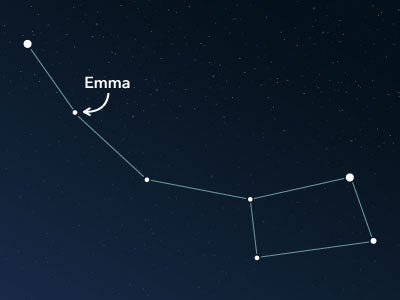The constellation Ursa Minor
Caractéristiques
- Nom latin
- Ursa Minor
- Hémisphère
- Hémisphère nord
- Visibilité
- All year round
- Région
- 256 deg²
- Étoile la plus brillante
- Polaris (HIP number 11767)
- Spécialités
- Galaxies

The Ursa Minor, commonly named Little Bear or Little Dipper, is one of the 48 constellations described by the Greco-Roman astronomer Claudius Ptolemy in ancient times. There are only a few interesting deep-sky objects to observe in its area.
Hemisphere, visibility, and area
The constellation is located at the northern celestial pole and is, therefore, only visible from the northern hemisphere. It is circumpolar up to 1° north latitude and can be observed all year round. However, it is not visible in more southern regions.
The Ursa Minor stretches over an area of approximately 256 square degrees in the night sky. In comparison to the other 88 constellations, it ranks 56th in size.
The visualization of the constellation resembles the Big Dipper, which is a part of the Ursa Major. It also features four stars in a square shape with a long chain of stars extending from one corner. The star chain, which represents the dipper's handle, depicts the bear's tail.
The northernmost point of this star chain is marked by the star Polaris (Latin: α Ursae Minoris, Alpha Ursae Minoris). It is located right at the celestial North Pole and is also known as the Pole Star or North Star. With an apparent magnitude of about 1.97, it is the brightest star in Ursa Minor.
Polaris and the three neighboring constellations serve as good orientation points when searching for Ursa Minor. The constellation Draco borders it to the south, while Cepheus is located to the west and Camelopardalis to the east.
Specialties in the constellation
There are several galaxies located in the area of the constellation Ursa Minor.
The barred spiral galaxy with the catalog number NGC 5832 is located about 27 million light-years away from the Milky Way. It was discovered by the German-British astronomer William Herschel in March 1785.
The other galaxy is cataloged as NGC 6217, known as Arp 185. It is an active barred spiral galaxy and was also discovered by William Herschel, but about 20 years later. Its distance from the Milky Way is estimated to be roughly 70 million light-years. The galaxy can be observed at the midpoint between the two stars η Ursae Minoris (Eta Ursae Minoris) and ε Ursae Minoris (Epsilon Ursae Minoris).
History and mythology
Ursa Minor is said to have been first mentioned as a separate constellation around 600 BCE. Thales of Miletus, an astronomer in ancient Greece, is said to have introduced the constellation at that time. However, there are no contemporary records to support this.
Until then, something else was interpreted into the constellation.
In Greek mythology, the constellation is associated with a legend about Zeus and his lover Callisto. There are two different interpretations.
In one story, Zeus is in love with Callisto, and they have a son named Arcas. Out of jealousy, Zeus' wife Hera eventually transforms the nymph Callisto into a bear and banishes her to the forest.
Several years later, Arcas encounters his mother in the forest again. However, he does not recognize her in her bear form and begins to chase her. Before a tragedy occurs, Zeus intervenes. He places both as bears in the sky: Callisto as the Big Bear (Ursa Major) and Arcas as the Little Bear (Ursa Minor).
The other interpretation is very similar. Here, Zeus transforms Callisto and Arcas into bears and hurls them toward the sky. This explains the creation of their characteristic long tails.
Again, Zeus' wife, Hera, is jealous and asks two sea gods for a favor. They are to deny the two bears a bath in the waters. This created the perception that the two constellations forever circle around the celestial pole and never sink toward the water on the horizon.
PubliéLire d'autres articles intéressants

An overview of all 88 constellations
Learn more about all 88 constellations and read interesting information about the mythology, visibility, and features.

Application Planétarium
Découvrez le ciel nocturne avec notre application de planétarium !
Disponible pour iOS et Android.

Nommez une étoile dans la constellation Little Bear, Little Dipper
Name a star in a constellation and create something that lasts for eternity.